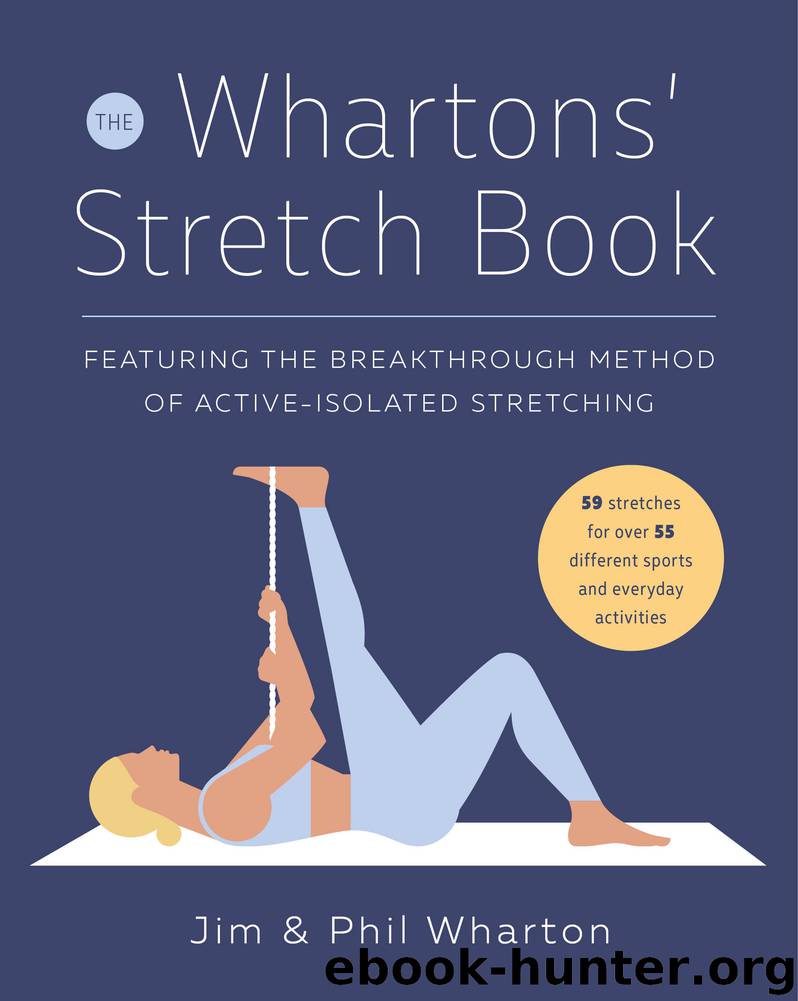The Whartons' Stretch Book by Jim Wharton & Phil Wharton

Author:Jim Wharton & Phil Wharton
Language: eng
Format: epub
Publisher: Potter/Ten Speed/Harmony/Rodale
Published: 2019-07-01T16:00:00+00:00
Horseback Riding
Stretches: Upper Legs, Hips, and Trunk 1–17
Shoulders 18–27
Neck 28–34
Arms, Elbows, Wrists, and Hands 35–46
Coaches’ Notes
What’s beautiful, weighs 1,200 pounds, towers over your head, wears steel-shod shoes that can crack a bone with one well-placed kick, can run you down at 40 mph, lets you sit on his or her back (sometimes), loves grain above honor, and has a brain the size of your fist? Right! HORSE! And like all things truly beautiful, a horse is also a little dangerous.
Most of the injuries we see in horseback riding take place on the human half of the duo and result from accidents. And most accidents take place among the “green horns” (cowboy talk for “beginners”). Horseback riding is twenty times more dangerous than riding on a motorcycle. Little wonder. We all think we know how to ride. We’ve seen riders a million times on the big screen. Elizabeth Taylor and Velvet. Roy Rogers and Trigger. You just climb into the saddle, masterfully seize the reins, give the horse a little nudge with your boot heels, holler “GIDDY UP!” and go. It takes only seconds to wonder how you could have been oh, so wrong.
Riding styles and equipment vary, but basically the rider is mounted in unstable equilibrium above the horse’s center of gravity and mass. To counterbalance the mass and weight of the rider’s body, his or her legs hang down over the horse’s sides with the feet planted in the stirrups to help stabilize the rider. Leaning too far forward puts the rider at risk for rolling over the horse’s shoulder if the animal stops suddenly. Leaning too far back creates the risk of a backward somersault over the horse’s tail. Balance is the key. The ground is a long way down, especially for your head—which is, incidentally, positioned at the highest point on this horse–rider configuration and consequently has the farthest distance to fall. We insist (no discussion) that you wear a helmet at all times, no matter how short your planned ride.
Riding uses your whole body. Your hips, legs, and feet allow you to mount and dismount. They also hold you in the saddle and are used for the signals you need to direct the horse. Your back holds you erect and allows you to pivot in the saddle to change position. Your shoulders, arms, and hands balance you and allow you to operate the reins. Overuse injuries are common, especially knee and ankle strains from badly fitted stirrups and incorrect positioning of feet. Additionally, we see some quad strain from struggling to hold an upright position and from keeping the fanny from banging on the saddle by suspending it an inch or so above the leather for the duration of the entire ride. We see fatigued backs from having the buttocks pound against the saddle in hard riding. And finally, we see “saddle bootie”—sore buttocks from an unfamiliar and unfriendly seat surface.
Download
This site does not store any files on its server. We only index and link to content provided by other sites. Please contact the content providers to delete copyright contents if any and email us, we'll remove relevant links or contents immediately.
How to Be a Bawse: A Guide to Conquering Life by Lilly Singh(7437)
Deep Work by Cal Newport(6966)
The Longevity Diet by Valter Longo(5042)
The Fat Loss Plan by Joe Wicks(4876)
The Four-Pack Revolution by Chael Sonnen & Ryan Parsons(3945)
The Ultimate Bodybuilding Cookbook by Kendall Lou Schmidt(3906)
The French Women Don't Get Fat Cookbook by Mireille Guiliano(3631)
Super Food Family Classics by Jamie Oliver(3383)
Not a Diet Book by James Smith(3377)
Factfulness_Ten Reasons We're Wrong About the World_and Why Things Are Better Than You Think by Hans Rosling(3216)
Turn Up Your Fat Burn! by Alyssa Shaffer(3196)
Self-Esteem by Matthew McKay & Patrick Fanning(3115)
Tom Kerridge's Dopamine Diet: My low-carb, stay-happy way to lose weight by Kerridge Tom(3082)
Body Love by Kelly LeVeque(3030)
The Unbecoming of Mara Dyer by Michelle Hodkin(3019)
The Fat Chance Cookbook by Robert H. Lustig(2812)
Tone Your Tummy Type by Denise Austin(2812)
LL Cool J's Platinum 360 Diet and Lifestyle by LL Cool J(2710)
Men's Health Best by Men's Health Magazine(2573)
